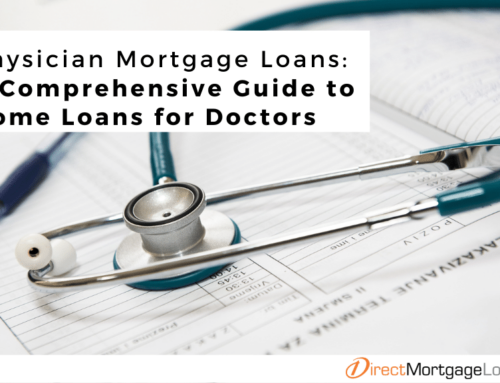Adjustable rate mortgages (ARMs) are gaining popularity among homeowners due to their unique blend of affordability and flexibility. While adjustable rate mortgages (ARMs) might work for some borrowers, it’s essential to grasp the risks tied to them before determining if an ARM fits your needs.
Subscribe to our blog to receive notifications of posts that interest you!
Adjustable-Rate Mortgage (ARM) Explained
An adjustable rate mortgage (ARM), also known as a variable-rate mortgage, is a type of home loan where the interest rate can change over time. Unlike a fixed rate mortgage, which keeps the same interest rate throughout the loan period, an adjustable rate can go up or down based on market conditions. This means that the monthly mortgage payments may increase or decrease, depending on how the interest rate changes.
Furthermore, the mortgage usually starts with a lower initial rate, making it attractive for those looking for an affordable start. Do keep in mind that rates can fluctuate in the future, meaning your monthly mortgage payment could increase.
Adjustable Rate vs Fixed
The two main types of mortgages are fixed-rate and adjustable-rate (ARM). A fixed-rate mortgage could begin with a higher initial rate but remains constant throughout the entire loan period. It’s ideal for those seeking predictability and intending to stay in their home for the long term.
In contrast, an adjustable-rate mortgage (ARM) begins with a lower interest rate for a set period (e.g., 3, 5, or 7 years), but after this, the rate could change based on market conditions. This may result in fluctuations in monthly payments. Nonetheless, ARMs are attractive for budget-conscious individuals but are better suited for those comfortable with potential payment adjustments and with shorter-term housing plans.
How does an ARM loan work?
Many components of an adjustable-rate mortgage play a huge part in what you will end up paying. Here is a breakdown of how an ARM loan works:
Initial Rate and Payment
One aspect of an Adjustable-Rate Mortgage (ARM) is the initial rate and payment. When closing on your home, you’ll receive an initial interest rate and monthly mortgage payment. However, with an ARM, this initial rate and payment are only fixed for a short period, usually ranging from 1 month to 5 years or more.
It’s important to note that the rate and payment can undergo significant changes or remain relatively stable, and these changes may not necessarily align with shifts in the overall market interest rates. To gauge potential variations, consider asking your lender for the annual percentage rate (APR). A higher APR compared to your initial rate could indicate a greater likelihood of a significant increase when the rate adjusts. Understanding that this is an estimate based on experience and not a guaranteed outcome.
Adjustment Period
The adjustment period refers to the duration between rate changes in an adjustable-rate mortgage. This period can vary, with interest rate and monthly payment adjustments occurring monthly, quarterly, yearly, or over an even longer timeframe. For instance, a 3-year ARM means your rate and payment change once every three years, aligning with the adjustment period.
Interest-Rate Caps
Interest rate caps are protective measures in Adjustable-Rate Mortgages (ARMs) that limit how much the interest rate can change, usually with a focus on preventing increases. These caps provide borrowers with a level of predictability and help manage potential financial risks associated with adjustable rates. The three main types of interest rate caps:
- Initial Adjustment Cap: This cap limits the initial change in the interest rate during the first adjustment period after the introductory fixed-rate period. It sets a maximum percentage increase to ensure that borrowers don’t face a sudden and drastic rise in their interest rates.
- Periodic Adjustment Cap: The periodic adjustment cap limits the amount by which the interest rate can change during each subsequent adjustment period. This cap provides ongoing protection, preventing large and unexpected jumps in interest rates at regular intervals.
- Lifetime Cap: The lifetime cap sets the maximum allowable increase in the interest rate over the entire lifespan of the loan. This cap provides a ceiling, ensuring that, regardless of market fluctuations, the interest rate cannot surpass a predetermined limit.
Understanding these interest rate caps is important for borrowers with ARMs, as it helps them anticipate and plan for potential changes in their mortgage payments. It provides a degree of stability and protection against excessive interest rate hikes, contributing to better financial management over the life of the loan. Borrowers should carefully review the terms of their ARM, including the specific caps in place, to make informed decisions about their mortgage.
Conforming vs. Non Conforming Loan
Conforming and non conforming loans are two types of mortgages that differ in their adherence to specific underwriting guidelines. Conforming loans must meet the criteria established by Fannie Mae and Freddie Mac, while non conforming loans do not. This difference affects the terms and conditions of the loans, including interest rates, down payment requirements, and eligibility criteria.
In general, conforming loans are a good option for borrowers with good credit scores and who are purchasing homes within the FHFA loan limits. Conversely, non conforming loans may be a better option for borrowers who do not meet the criteria for conforming loans. Nevertheless, you should be aware of the potential for higher interest rates and stricter requirements.
Conforming Loans
A conforming loan is a mortgage that adheres to the loan limits established by the Federal Housing Finance Agency (FHFA) These loans are typically purchased by Fannie Mae and Freddie Mac, which allows lenders to offer lower interest rates and more flexible terms.
Non Conforming Loans
A non conforming loan is a mortgage that doesn’t adhere to the guidelines set by government-sponsored enterprises like Fannie Mae and Freddie Mac. Jumbo loans, specifically, fall under the non-conforming loan category, since they exceed conforming loan limits. Moreover, non-conforming loans often have higher interest rates and stricter requirements due to increased risk for lenders.
Conventional Vs. Government-Backed ARM Loans
The main difference between a conventional ARM and a government-backed ARM is the source of the funding. Conventional ARM loans are funded by private lenders, while government-backed ARM loans are insured by the federal government. Additionally, government-backed ARM loans typically have more lenient qualification requirements than conventional ARM loans. This is because the government guarantees the loans, which reduces the risk for lenders.
Can you refinance an ARM loan?
Yes, you can refinance an ARM loan. Refinancing an ARM loan is the process of replacing your existing ARM with a new mortgage loan. This can be done for a variety of reasons, such as to lock in a lower interest rate, to shorten the loan term, or to change the type of mortgage loan. Here are the steps to refinancing an adjustable-rate mortgage (ARM):
- Define Your Goals: Clearly outline your objectives. Do you want to lower your interest rate, shorten the loan term, or switch from an ARM? Knowing your goals helps you narrow down your options.
- Check Credit Score and Equity: Before exploring a refinance, check your credit score and home equity. Your credit score affects your interest rate, and your equity determines how much you can borrow against your home.
- Gather Documents: Collect necessary documents like pay stubs, bank statements, W-2s, and tax returns. Lenders use these to assess your financial stability and eligibility for refinancing.
- Submit Application: Complete a mortgage refinancing application. This involves providing personal financial information for the lender to evaluate your eligibility for the new loan.
- Lock in Interest Rate: Consider locking in your interest rate to secure a favorable rate during processing, protecting you from potential increases before closing.
- Wait for Approval: An underwriting will assess your financial dependability and eligibility for the new loan, considering your financial history, assets, and liabilities.
- Closing Phase: If approved, move to the closing phase. Review new loan terms, pay closing costs, and sign necessary documents. The new loan pays off the existing ARM.
- Start New Loan Payments: After closing, begin making payments on your new mortgage, which may include lower monthly payments, a fixed interest rate, or other terms aligning with your financial goals.
Inquire about our refinancing options by contacting an expert Loan Officer!
5/1 and 5/6 ARMs
These ARM loans provide a fixed interest rate for the initial 5 years. The second number indicates how often the rate adjusts after the first 5 years. In a 5/1 ARM, the rate adjusts yearly, while a 5/6 ARM adjusts every 6 months.
7/1 and 7/6 ARMs
These ARMs offer a fixed rate for the initial 7 years, followed by 23 years of fluctuating payments based on changing interest rates. Remember, your mortgage payment may increase or decrease depending on interest rate fluctuations
10/1 and 10/6 ARMs
With a fixed rate for the first 10 years, 10/1 and 10/6 ARMs involve changing payments for the remaining 20 years. The interest rate will vary based on market conditions, influencing your monthly mortgage payments.
Pros of an Adjustable Rate Mortgage (ARM)
There are many advantages to an adjustable-rate mortgage:
Lower Introductory Interest Rate
ARMs typically offer lower introductory interest rates than fixed-rate mortgages, which can save you money on your monthly payments during the initial period of the loan.
Flexibility
ARMs can offer more flexibility than fixed-rate mortgages. For example, some ARMs allow you to skip payments or convert to a fixed-rate mortgage during the introductory period.
Potential for Lower Interest Rates Over Time
If interest rates decline, your ARM’s interest rate could also decline, which could save you money on your monthly payments over the long term.
Cons of an Adjustable-Rate Mortgage (ARM)
Here are a few cons to consider before opting for an adjustable-rate mortgage.
There is one big disadvantage to consider with an adjustable-rate mortgage:
- Risk of rising interest rates: If interest rates rise, your ARM’s interest rate could also rise, which could increase your monthly payments.
- Uncertainty: It can be difficult to predict how your ARM’s interest rate will change over time, which can make it harder to budget for your monthly mortgage payments.
When should you consider an adjustable rate mortgage?
Considering an adjustable-rate mortgage (ARM) can be beneficial in various scenarios. To begin, if you have short-term residence plans and intend to sell or refinance your home within the initial fixed-rate period, an ARM provides a favorable option. Seize the opportunity of a lower initial interest rate, allowing you to address your housing needs before the rate adjusts.
Additionally, if you anticipate an increase in your income, choosing an ARM could be a wise option. The lower initial interest rate allows you flexibility in making higher monthly payments when the rate eventually adjusts.
For those comfortable with uncertainty regarding future monthly payments, an ARM loan could be a suitable choice. Since ARM rates are subject to adjustment, being at ease with this unpredictability and having a plan to navigate potential rate increases is crucial.
If you desire a lower initial interest rate and are open to accommodating potential rate increases in the future, an ARM loan is worth considering. The initial interest rate typically surpasses that of a fixed-rate mortgage, providing an attractive starting point for your mortgage journey.
*Eligibility and approval is subject to completion of an application and verification of home ownership, occupancy, title, income, employment, credit, home value, collateral and underwriting requirements. Direct Mortgage Loans, LLC NMLS ID# is 832799 (www.nmlsconsumeraccess.org). Direct Mortgage Loans, LLC office is located at 11011 McCormick Rd Suite 400 Hunt Valley, MD 21031. Equal housing lender.*






Leave A Comment
You must be logged in to post a comment.